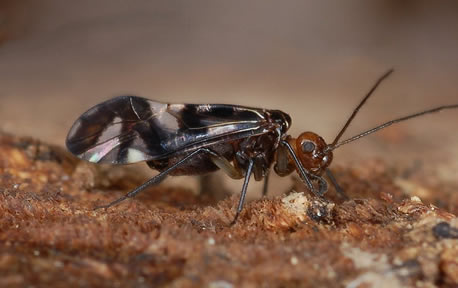Psocoptera
Pronunciation: [Pso⋅COP⋅ter⋅a]
Pronunciation: [Pso⋅COP⋅ter⋅a]
Common Name: Psocids / Barklice / Booklice
Greek Origins of Name: Psocoptera is derived from the Greek “psokos” meaning rubbed or gnawed and “ptera” meaning wings. This name has been criticized by many entomologists because the prefix (a clear reference to the manner of feeding) is unrelated to the suffix (the presence of wings). Loosely translated, however, the name could be taken to mean “winged insects that gnaw”.

Development: Hemimetabola, i.e. incomplete metamorphosis (egg, nymph, adult)
Taxonomy: Hemipteroid; closely related to Hemiptera and Phthiraptera
The order is divided into three suborders (Trogiomorpha, Troctomorpha, and Psocomorpha) which are distinguished by the number of segments in the antennae, tarsi, and labial palps.
Distribution: Abundant worldwide, but often overlooked because of their secretive habits. Approximately 22 family and 245 species in North America and 35 family and ~3200 species worldwide
The order Psocoptera (also known as Corrodentia) contains the booklice and barklice. These insects are often regarded as the most primitive hemipteroids alive today because their mouthparts show the least modification from the primitive mandibulate condition. In fact, only the lacinia (a subdivision of the maxilla) has become a separate, rod-like structure that is pushed against the substrate as a brace while the mandibles scrape off surrounding food particles. The pharynx and hypopharynx are also modified for grinding food in a mortar-and-pestle arrangement.
Barklice generally live in moist terrestrial environments (in leaf litter, beneath stones, on vegetation, or under the bark of trees) where they forage on algae, lichens, fungi, and various plant products. They may grow to 10 mm in length and are frequently winged during the adult stage. Some species are gregarious. They often live in small colonies beneath a gossamer blanket spun with silk from their labial glands. Booklice are more common in human dwellings and warehouses. They are wingless and much smaller than barklice (less than 2 mm). Most species feed on stored grains, book bindings, wallpaper paste, fabric sizing, and other starchy products.
Although most Psocoptera are free-living, a few genera live in the nests of birds. They survive by feeding on residues of feathers or skin cells, but never on the birds themselves. Most entomologists suspect that true lice (ectoparasites of birds and mammals) evolved directly from these commensal barklice. Even today, it is possible to find a gradual progression of species with increasing dependence on vertebrate hosts. A close phylogenetic relationship between barklice and parasitic lice is also suppported by similarities in the structure of mouthparts (particularly the hypopharynx).
Appearance of Barklice:

Appearance of Booklice:

Most of the psocids are woodland insects that rarely come into contact with humans. Species that do inhabit homes and warehouses may occasionally become a nuisance, but they seldom cause economic damage.
Trogiidae (Granary Booklice) — a cosmopolitan family with several species that may be pests of stored grain (e.g., Lepinotus reticulatus and L. inquilinus).
Liposcelidae (Booklice) — includes Liposcelis bostrychophilus, a tiny, wingless species commonly found in old books and papers.
Psocidae (Common Barklice) — the largest family in the order. Most of these species are found outdoors on bark or under rocks.